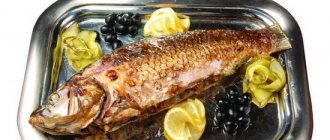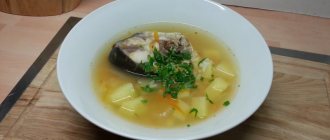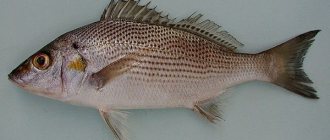Macrurus (grenadier) is an inhabitant of the deep sea, reminiscent of ancient prehistoric monsters.
It is found in Antarctica, the Atlantic and Pacific oceans, and is found in the Sea of Okhotsk. The appearance is repulsive, but meat dishes are considered delicacies. In the article we will look at what kind of grenadier fish this is and what its benefits are for the human body. Have you tried grenadier?
- Yes 58%, 480 votes
480 votes 58%480 votes - 58% of all votes
- No 42%, 346 votes
346 votes 42%
346 votes - 42% of all votes
- I don't eat fish 1%, 7 votes
7 votes 1%
7 votes - 1% of all votes
Total votes: 833
26.09.2019
×
You or from your IP have already voted.
Origin of the species and description
Photo: Makrurus
Macrurus is a deep-sea fish from the ray-finned class. This is the largest class - the vast majority of fish (about 95 percent) are ray-finned. These fish are also distinguished by the fact that they are objects of active fishing, and grenadier is no exception. Ray-finned fish are the most ancient representatives among fish. Early finds of these fish are more than 40 million years old - they were large predatory fish of the Silurian period. For the most part, the fish preferred cold waters, living in Russia, Sweden, and Estonia.
Video: Makrurus
Ray-finned fish were replaced by bony fish, but in the course of evolution, ray-finned fish defended their place in the world's oceans. Thanks to the bony spine and light structure of the fins, they acquired maneuverability and the ability to survive at great depths. Macrurus is one of these deep-sea fish that has retained the morphology of the ray-finned class, but at the same time is able to survive in low temperatures and high pressure. Grenadier is distributed in many waters, therefore it has more than three hundred subspecies, differing in morphology.
The most common types:
- the small-eyed longtail is the largest representative of grenadiers, which can only be found in cold waters;
- Antarctic - a large fish, difficult to catch due to its habitat;
- comb-scaled - not very popular in the fishery due to its specific taste and small amount of meat;
- South Atlantic - the most common subspecies in the fishery;
- small-eyed - the smallest representative of grenadiers;
- Berglax - distinguished by the most bulging eyes.
At what age can children be given hoki?
You can try to give this fish to a child no earlier than 11-12 months, when the baby’s digestive system is almost formed.
Cases of allergies or individual intolerance to this product in children are extremely rare, but in any case, at the slightest suspicion, it is better to consult a pediatrician.
A growing body urgently needs iron, potassium, phosphorus, and polyunsaturated fatty acids, which are present in sufficient quantities in this fish.

Rich catch!
Appearance and features

Photo: What grenadier looks like
Grenadier is an elongated, long fish, shaped like a drop. She has a large head and a body tapering towards the tail. The caudal fin itself is absent as such: the tail of the grenadier is called a filamentous process. Due to the shape of the tail, the fish is classified as a member of the long-tailed family. The head is very large. The bulging huge eyes of the grenadier stand out clearly on it, under which there are hard eye ridges. The grenadier is completely covered with thick, sharp scales - the reason why the fish cannot be handled without gloves, since there is a high probability of cutting yourself.
Interesting fact: On store shelves, this fish can only be seen in cut form, or only fillets are sold. This is due to the unsightly appearance of the grenadier with its frightening eyes and large head.
The color of the grenadier is gray or brown, with pale gray stripes. On the back of the grenadier there are two gray fins - one short and high, and the second low and elongated. The pectoral fins have the appearance of elongated rays. The weight of a female grenadier of the largest subspecies can reach six kg. The length of the Atlantic grenadier is from one to one and a half meters, the average length of a female varies between 60 cm and 3 kg of weight. The mouth is filled with sharp teeth in two rows. Sexual dimorphism is minimal, most often expressed in the size of the grenadier.
Interesting fact: Due to its shape and thin long tail, in the old days the grenadier was compared to rats and was believed to be a carrier of infection.
The most colorful representative of grenadiers is the giant grenadier. All subspecies of grenadier, except the small-eyed one, can have similar gigantism. Its length can reach two meters, and its weight is more than thirty kg. Giant grenadiers are, as a rule, very old individuals that go to a depth of more than 4 thousand meters.
Macrurus: calorie content and nutritional value
The calorie content of fish is 60 kilocalories per 100 grams of product. Fish has high nutritional value. It contains: 7 grams of protein, 0.4 grams of fat, 91 grams of water, 1.7 grams of ash, 0.096 grams of omega-3 fatty acids and 0.009 grams of omega-6 fatty acids, a large number of vitamins: 29.7 mcg - vitamin A , 0.078 mcg - vitamin B1, 0.194 mcg - vitamin B2, 1.383 mcg - vitamin C, 1.948-PP, 4.748 mcg - B6.
Microelements included in grenadier:
- iron;
- manganese;
- fluorine;
- zinc;
- molybdenum;
- copper;
- iodine;
- nickel;
- cobalt;
- chromium.
Macroelements contained in fish:
- potassium;
- sulfur;
- calcium;
- phosphorus;
- sodium;
- chlorine.
Where does grenadier live?

Photo: Macrurus at sea
Grenadier is a bottom-dwelling fish that lives mainly in the Atlantic and Pacific oceans. The depth at which it occurs is from two to four km, but sometimes it is greater.
The main grenadier fishery is concentrated in the following places:
- Russia;
- Poland:
- Japan;
- Germany;
- Denmark;
- North Carolina;
- sometimes in the Bering Strait.
About two hundred species of grenadier live in the Atlantic Ocean - this is the majority of the population. It is also found in the Sea of Okhotsk, but only four species are found there, and the population has become significantly smaller due to fishing. Russia is one of the largest grenadier fisheries.
Most often it is caught in the following places:
- Alexandra Bay;
- coast of Kamchatka;
- big Shantar.
Young grenadiers live in the upper layer of water, often floating to the surface. Old fish go to the bottom, where they spend the rest of their lives: the older the fish, the closer to the bottom it lives. Adult grenadiers are more valued as a commercial fish, so their catch is complicated by their bottom habitat.
Interesting fact: Macrurus are caught using large nets and special vessels that can support the heavy weight of the fish.
What does grenadier eat?

Photo: Makrurus in Russia
Macrurus is a predatory fish. Its main diet includes various crustaceans and mollusks, as well as small fish. Macrurus are not active predators; they prefer to sit on the bottom in ambush, waiting for the prey to swim up to it. The grenadier is helped in this by its camouflage color, with which it blends in with the bottom. How much grenadier eats depends on the time of year. In winter, these fish live on the bottom, lose significant weight and rarely eat. During the breeding season, grenadiers also rarely eat, but after the mating season they actively gain weight and are even capable of active hunting - pursuing prey. Macrurus are caught not only with nets, but also with bait.
The main bait that grenadier bites on is:
- small shrimp;
- large worms;
- shellfish;
- crab meat (can be slightly spoiled for a stronger smell);
- scallops;
- echinoderm fish;
- sardine;
- cuttlefish and other cephalopods.
In the wild, it has been observed that grenadiers love squids, brittle stars, amphipods, anchovies and benthic polychaetes. These products are also used as bait, but only young grenadiers usually bite on them. Catching grenadiers with bait is difficult and energy-consuming. This will take a lot of time and a lot of bait as other fish are more likely to bite on it. A more common type of fishing for grenadiers is with large nets that can reach adult bottom-dwelling specimens.
How to choose when purchasing and how to store
How tasty the dish turns out depends on the correct choice. Before purchasing macros, you need to carefully inspect them. There should be no thick ice on it. This indicates possible repeated freezing of the product and loss of taste.
If possible, it is better to take chilled meat. Also, you should not buy if there are stains or bloody spots on the carcass. When there is doubt about the freshness of a product, there is no need to purchase it at all.
Stale fish turns into mush when cooked. It can disappoint not only with its taste, but also lead to poisoning. As for defrosting, it should not be defrosted in the microwave or under running water. It is optimal to prepare meat for cooking at room temperature.
A frozen product can be stored in the freezer for up to two months, after defrosting - no more than four hours.
What to cook?
Features of character and lifestyle

Photo: Grenadier fish
The lifestyle of grenadiers varies depending on the habitat and age of the fish. It is customary to distinguish several types of fish lifestyle. Bottom - at a depth of more than 4 thousand meters. This lifestyle is typical for adults and giant grenadiers.
500-700 meters is the most common depth at which grenadiers are found. Most networks are designed for it. Only young animals and females live at the surface of the water. Basically, only male grenadiers prefer to live on the bottom. Females and young animals stay in the water column and often float to the surface.
Grenadier is a cautious fish that leads a sedentary lifestyle, which makes them difficult to catch. They cannot be seen when the grenadier is hidden at the bottom, since it blends into the relief. They are not distinguished by aggressive behavior; in case of danger, they prefer not to defend themselves, but to flee. During the mating season, male grenadiers can be aggressive, including towards humans.
The grenadier's bite is not fatal, but painful due to two rows of sharp teeth, and the grenadier's jaws are strong enough to bite through the durable chitin of crustaceans and mollusks.
Macrurus: benefits and harm
Fish have a number of beneficial properties. Among them are:
- strengthens the skeletal system;
- used during diets;
- maintains muscle tone;
- normalizes the condition of nails and hair;
- removes toxic substances from the body;
- prevents the occurrence of cancerous tumors;
- stimulates the functioning of brain cells;
- has a positive effect on the gastrointestinal tract;
- supports normal functioning of the thyroid gland;
- restores strength after prolonged illnesses and operations.
Negative aspects of the product:
- Pregnant and lactating women are prohibited from using the product;
- Causes an allergic reaction in a person prone to allergies.
Social structure and reproduction

Photo: Macrurus under water
Grenadiers are spawning fish that reach sexual maturity at the age of 5 to 11 years (this depends on the grenadier subspecies). The size of the fish matters - at least 65 cm, but not more than 100, since large fish are considered too old for reproduction. Females and males live separately - females in the water column, and males hiding at the bottom. Therefore, females lead a more active lifestyle, hunt more often and become objects of hunting more often. Spawning for grenadiers lasts all year round, but reaches its peak in the spring. The hidden lifestyle of this fish does not allow us to determine whether grenadiers have any mating games and rituals.
It has been observed that males become more aggressive during spring spawning. They can bite each other and attack other fish species. Males also lose significant weight during spawning, as they are constantly searching for females. The female lays more than 400 thousand eggs, the diameter of which is about one and a half mm. The female does not show any care for the eggs, so most of the eggs are eaten by various fish, including the grenadiers themselves. Cannibalism is not uncommon among this species. There are no exact data on the lifespan of grenadiers, but most species live to more than 15 years.
Scale studies have shown approximately how long grenadiers live in the following waters:
- fish from the Sea of Okhotsk live to about twenty;
- grenadiers of the Kuril Islands can live up to forty;
- The longest-living grenadiers so far are fish from the Bering Sea - they live more than 55 years.
How to cook grenadier in the oven
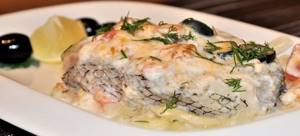
Macrurus baked in the oven is one of the most preferred methods of preparing such fish, in which the tender flesh remains juicy and maintains its integrity. In this case, the gutted carcass is stuffed with a mixture of vegetables and mushrooms, and at the end of baking it is topped with grated hard cheese.
Ingredients:
- grenadier – 1 piece;
- onion – 1 pc.;
- carrots – 1 pc.;
- mushrooms – 200 g;
- cheese – 50 g;
- salt, pepper, oil.
Preparation
- The fish is rubbed with salt and pepper.
- Onions, carrots and mushrooms are fried in oil.
- Season the filling, fill the fish with it, and place the rest on top of the carcass.
- Pack the fish in foil.
- The grenadier will be baked in the oven for 30 minutes at 200 degrees.
- 10 minutes before the signal, sprinkle the fish with cheese.
Natural enemies of grenadier
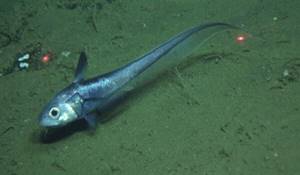
Photo: What grenadier looks like
Grenadier is a secretive and fairly large fish, so it has few natural enemies. The population is regulated by constant fishing and rare predatory fish that do not specifically hunt for grenadier.
Most often, grenadier becomes prey:
- various species of small sharks. These include the Atlantic herring shark, sawfish, deep-sea goblin shark, cat shark;
- large sixgill rays (white-headed, spineless), which often stumble upon the bottom shelters of grenadiers;
- Atlantic roughy, also leading a bottom-dwelling lifestyle;
- large varieties of tuna, some subspecies of sturgeon;
- the warlike bathysaurus is sometimes caught in nets together with grenadiers, which indicates their common habitats and the possibility of bathysaurs hunting grenadiers.
Macrurus does not have many enemies that could seriously depress its population. Most of the fish that live near the grenadier are protected or on the verge of extinction. Due to its body shape, grenadier is not capable of developing high speeds in flight from predators: its weak tail and large head allow it to be successful only in camouflage. At the same time, being a passive and sedentary fish, grenadier does not use strong jaws and sharp teeth for self-defense.
Delicious grenadier recipes

The meat of grenadier is quite specific; it is not like the ordinary fish that we are used to eating. It contains a lot of protein and little fat, which makes it a dietary product.
At the same time, meat is rich in various microelements and vitamins. Despite such positive qualities, this fish is not in demand, perhaps because it requires certain skills in preparation.
Cooking secrets:
- heat treatment should not be long, in which case the fish will fall apart and take on an unpleasant appearance;
- Avoid boiling or stewing fillets; it is better to fry, bake or make cutlets;
- It is better to defrost in the refrigerator, since the fillet is very tender and contains a lot of water, it can acquire the consistency of jelly when defrosted, for example in the microwave.
Macrurus in batter
- 1 fillet;
- 1 egg;
- 2 tbsp. spoons of sour cream;
- 2 tbsp. spoons of flour;
- pepper, salt, lemon juice, spices to taste;
- vegetable oil for frying;
- breadcrumbs.
Cut the fish into pieces no thicker than 2 cm. Sprinkle with lemon juice. For the batter, beat the egg, sour cream and flour. Add spices to taste. First dip the fillet in batter and then roll in breadcrumbs. Fry in a hot frying pan in a large amount of oil on both sides until the dough is browned.
Grenadier cutlets
- 1 grenadier fillet;
- 0.5 cup oatmeal;
- 1 onion;
- 1 egg;
- 1 tbsp. spoon of mayonnaise;
- dill;
- vegetable oil;
- salt, pepper - to taste.
Place finely chopped fillet, chopped onion and dill in a bowl. Add egg, mayonnaise, oatmeal, salt and pepper. To stir thoroughly. Place in the refrigerator for 1 hour. Make cutlets of the required size from the prepared minced meat and fry them on each side until golden brown.
Baked grenadier
- grenadier fillet;
- 1 onion;
- 1 medium carrot;
- salt, spices for fish;
- 2-3 tbsp. spoons of sour cream.
Cut the fillet into portions. Season with salt and roll in fish seasoning. Leave to marinate for 10-15 minutes. At this time, grate the carrots and cut the onion into rings. Place the fish on foil, add carrots and onions on top, cover everything with sour cream. Bake in the oven until cooked at 180°C.
Grenadier caviar is very tender and tasty, similar to salmon caviar, but while the latter is always available on store shelves, delicacy grenadier caviar can be found in few places. It is used to prepare salads, rolls, various snacks and sandwiches.
Let's celebrate! To enrich your diet and expand your taste preferences, you should try grenadier. The fillet of this fish is very tender, dietary and unusual. When properly prepared, the taste and consistency resembles crab meat, which will not leave lovers of seafood and fish indifferent.




